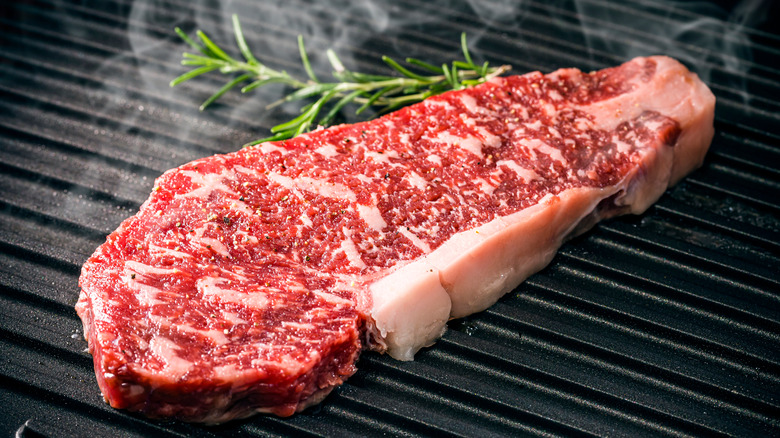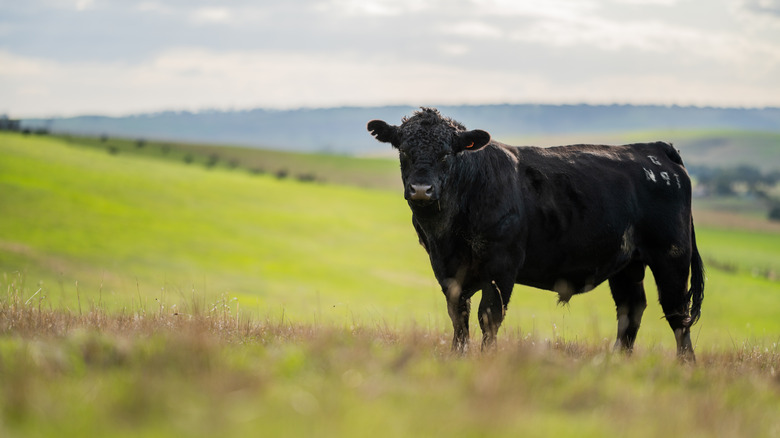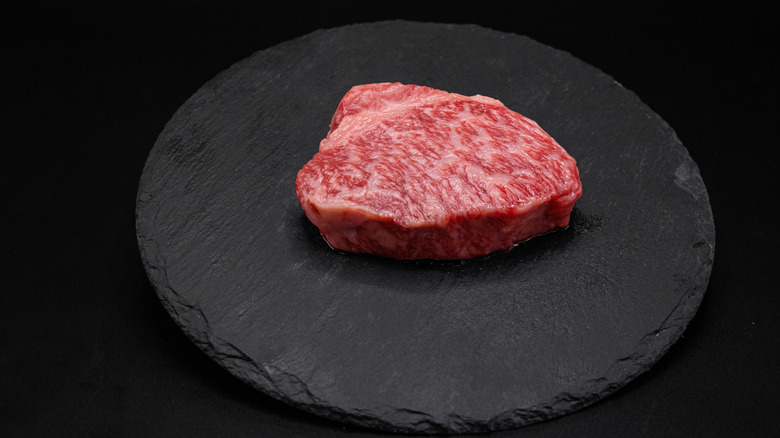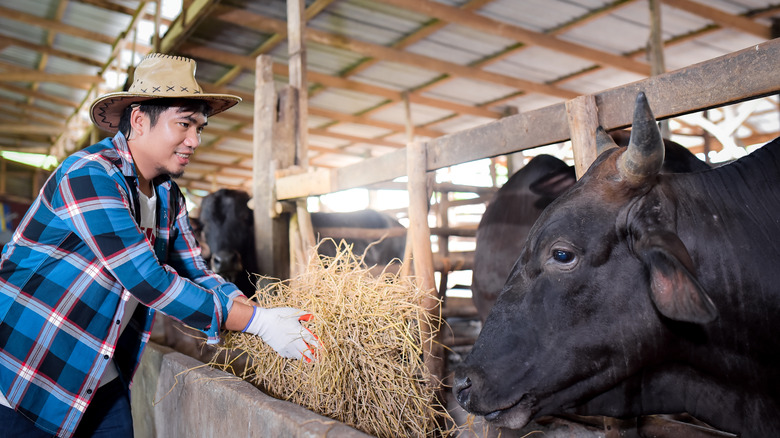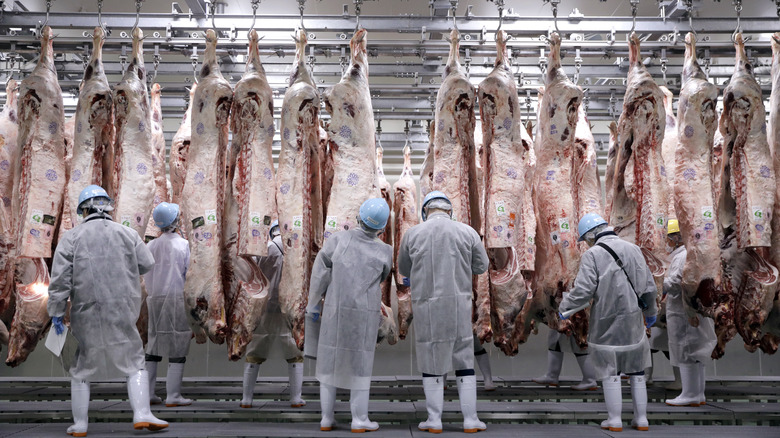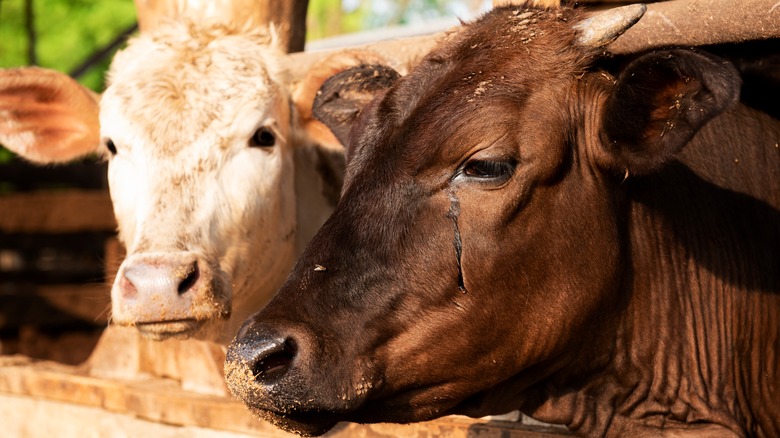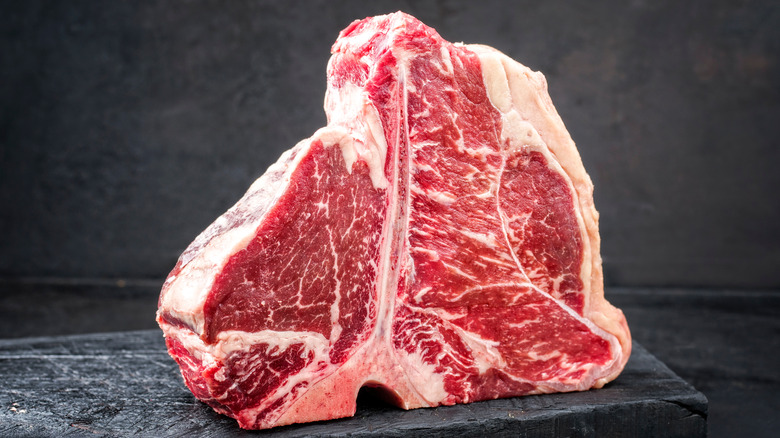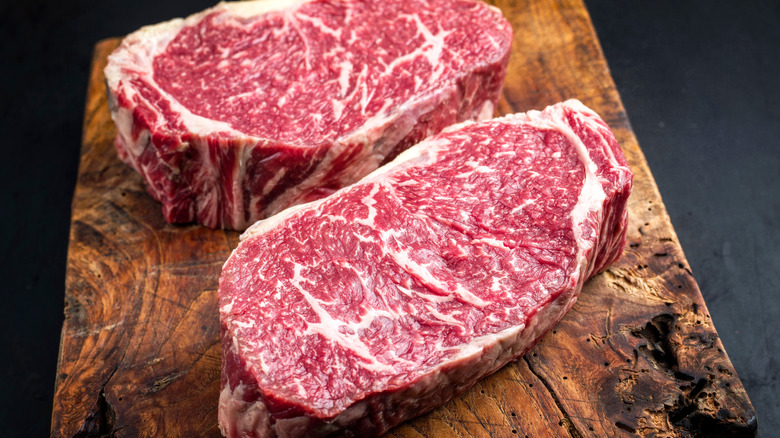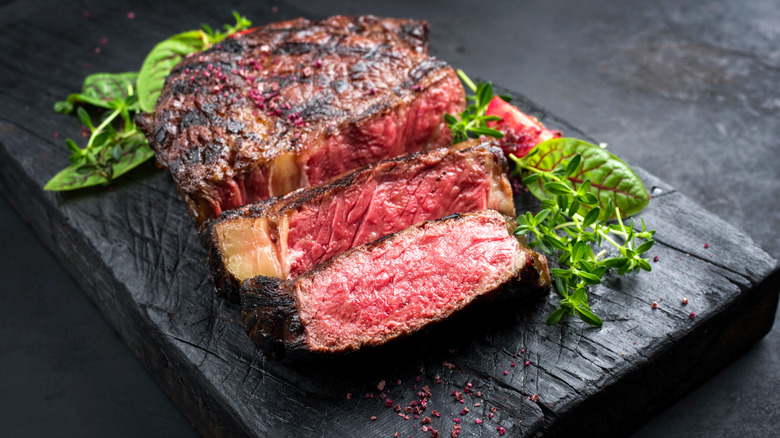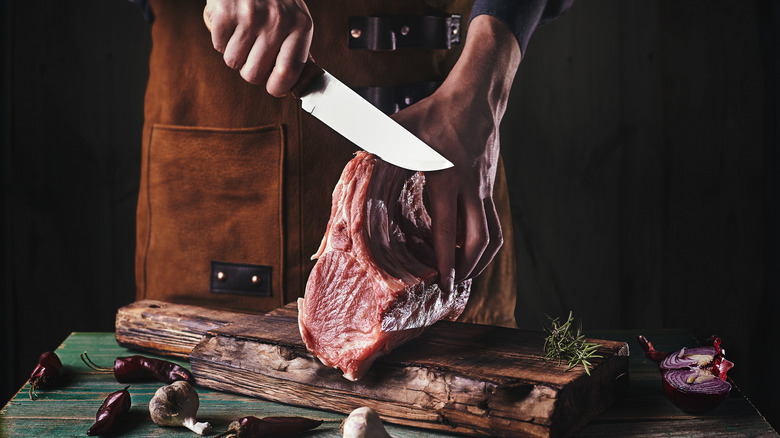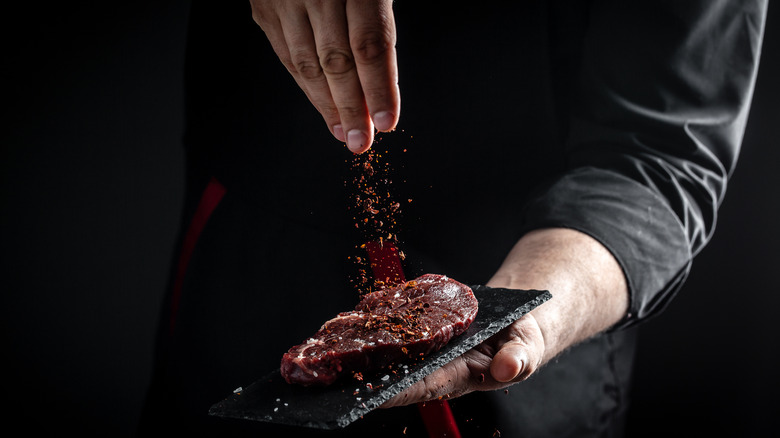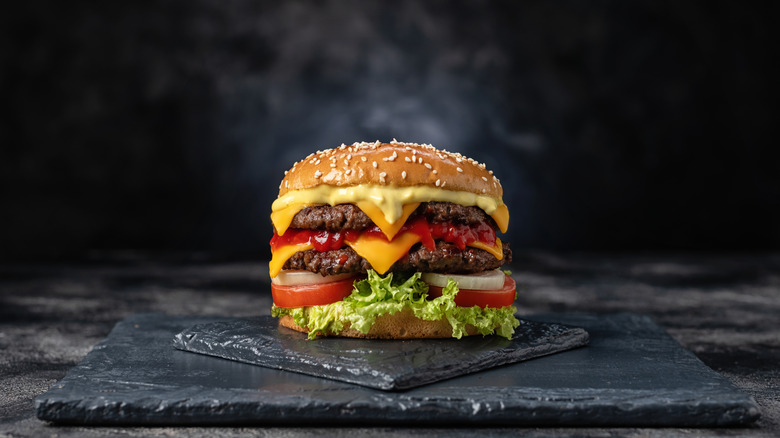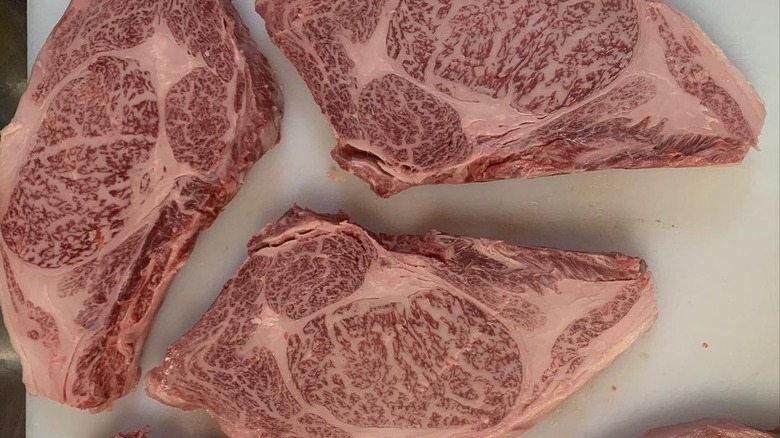The Untold Truth Of Wagyu Beef
Ask any foodie, and they'll tell you that one of the world's finest red meats is the Japanese delicacy Wagyu. Tender, fatty, and iridescently pink, high-quality cuts of Wagyu can garner as much as $200 per pound according to Business Insider. Like matsutake mushrooms or Almas caviar, Wagyu is associated with decadence, but this elusive food is as steeped in misconceptions as it is in luxury. What exactly is Wagyu? How do you know if it's authentic or not? Why is it so expensive? These are some of the most pressing questions on the minds of even the most savvy foodies.
Breeding, raising, and processing Wagyu beef is a practice that dates back to the 19th century in Japan, according to the American Wagyu Association. To this day, the Japanese government and Wagyu ranchers remain dedicated to tradition, and it's precisely this devotion to craft that has made Wagyu famous for its melt-in-your-mouth flavor that enthusiasts know and love. But there's more to this rich food than simply taste, so read on to learn more about its fascinating history, varieties, and nuances. This is the untold truth of Wagyu beef.
Wagyu refers to purebred Japanese cattle
The term Wagyu beef literally translates to Japanese cow, where "Wa" means Japanese and "gyu means "cow" (via American Wagyu Association). However, the simple definition belies the complicated facts behind the umami-rich delicacy. For starters, it's pronounced wah-gyoo, not wah-goo, a fairly common mispronunciation (via Robb Report). What's more, Wagyu isn't a blanket term for all Japanese cows. The Wagyu steak served at Michelin-starred restaurants refers to four specific breeds of Japanese cattle that have unique genetic traits.
The American Wagyu Association says that Wagyu breeds can trace their genetics as far back as 35,000 years. Modern Wagyu cows are the result of crossing native Japanese cattle with imported breeds, which began in 1868 when the government sought to integrate Western food into Japanese culture. Before this time, cows were primarily used as draft animals in agriculture and were bred primarily for physical endurance. Today, the four breeds of Japanese Black, Brown, Shorthorn, and Polled are considered Wagyu, although there are many sub-varieties of Wagyu cattle as well. According to Business Insider, the most premium cuts are sourced from only 10 regions, and one of the most expensive types is Matsusaka Wagyu, which is valued for its tenderness and comes from virgin female cows.
Logically, the Japanese government was keen to keep its Wagyu cows pure and thereby maintain its dominance over the breed, so in 1910, they banned interbreeding with British, European, and Asian varieties of cows.
Wagyu's high price tag is all in the marbling
What makes Wagyu beef taste so great? The answer should be immediately obvious looking at a slab of raw Wagyu, which is visibly distinguished by streaks of white fat interlaced throughout its pinkish meat. It's this remarkable amount of intramuscular fat, also known as "marbling," that give Wagyu its famous buttery flavor that critics rave about; the fat is also responsible for Wagyu's soft, tender texture (via Lone Mountain Wagyu). The marbling isn't just tasty: It also provides healthy fatty acids like omega-3 and omega-6
In fact, Wagyu cattle were originally bred for agricultural labor precisely because of their inherent genetic marbling — the extra fat in their flesh provided them with an additional energy source, so they were able to work harder and longer than regular cattle (via American Wagyu Association).
Comparatively, cuts of Choice and Select beef — official grades used by the USDA to evaluate meat — have less marbling, which means these leaner cuts are less juicy and tender. The marbling is also why Wagyu beef is so expensive. High-quality Wagyu can cost around $200 per pound and a Wagyu cow can sell for as much as $30,000 at auction (via Business Insider).
Wagyu beef is raised in a highly specialized way
Wagyu cows are naturally endowed with special genetic traits that lend their flesh a high degree of marbling, also called the "marbling gene." However, there's also a lot of work that goes into cultivating Wagyu beef to the point where it can sell for hundreds or even thousands of dollars (via Lone Mountain Wagyu).
First, Japanese ranchers ensure only the cattle with the best genes are bred for Wagyu beef production. Breeders gather and analyze data about their cattle's progeny, such as statistics on the calves' marbling, which helps to determine which pairs to breed together in the future to ensure the highest quality beef. In fact, according to the Pacific Wagyu Alliance, the Japanese government mandates offspring testing among its Wagyu cows. Calves are bottle-fed milk by hand until they're about 10 months old, at which point they're sold to another rancher who feeds them a special recipe of whole grains, though the specifics vary between farmers. Conventional cattle, on the other hand, are fed corn.
While regular cows are encouraged to gain weight quickly and are given hormones to speed up the process, this is not the case with Wagyu. During the fattening stage, each cow eats 5 tons of food (via Business Insider). Ranchers ensure they lead stress-free lives and expend as little energy as possible. This is because happier cows are tastier cows. Ranchers pamper their cows with special attention to achieve this goal.
Wagyu undergoes an intense grading process
According to Lone Mountain Cattle, once Wagyu cows are bred, raised, and processed for consumption, the next critical step on the way to diners' plates is grading. Beed is graded worldwide, but the process is especially stringent and highly regulated in Japan. Of course, this should come as no surprise since the government has a reputation to maintain when it comes to their national treasure.
Each Wagyu animal is assessed and scored based on two factors: the quantity of meat it can yield and how much marbling it has. The highest grade is A5, and Japan only sells cuts A3 to A5. Logically, cuts with higher grades garner higher price tags (via Business Insider). According to Michelin, A5 Wagyu is often a pale shade of pink with a flavor so sweet and rich that it's usually consumed in small amounts.
Per A Five Meats, Japanese inspectors are also highly trained professionals who undergo three years of training in which they master the trade underneath the apprenticeship of an accomplished industry expert. Each Wagyu animal is assessed separately by three different inspectors before it is given a final grade.
Lastly, every cut of Wagyu is given a unique identification number (via The Wagyu Shop). This allows every Wagyu cow to be traced, and provides a way to confirm the cattle's date of birth, heritage, and breed, which ultimately ensures authenticity. It also protects consumers and businesses from scams.
There is no single Wagyu
Wagyu is often used as an umbrella term, but Japan actually has over 200 brands of the prized beef (via Japan National Tourism Organization). Similar to how wine and cheese are often categorized according to region and method of cultivation, Japan classifies its beef by region, and each Wagyu brand meets different standards according to the production area. Just as Bordeaux, Burgundy, and Champagne wines only come from those specific wine-producing areas, regional brands of Wagyu can only come from certain parts of Japan.
For superior levels of marbling, the following are considered the top three Wagyu brands in Japan: Kobe, Matsusaka Ushi, and Ohmi beef. All of them originate from the region of Kansai, but each has a distinctive taste that sets them apart from one another.
Of the three, Kobe is the most well-known. It comes from Kobe City in Hyogo Prefecture. The cattle are fed a special mix of rice and corn, a diet that results in beef with high marbling, sweet flavor, and luscious texture. Matsusaka Ushi comes from virgin cows in Matsusaka City in Mie Prefecture. These cows are fed beer by ranchers who give them highly personalized care and attention. This results in beef with a particularly high fat content. Lastly, there's Ohmi wagyu from the Shiga Prefecture, where the distinctive beef is known for its tender fat. Historically, miso-marinated in Ohmi beef was often given to shogun — military leaders in feudal Japan — as medicine.
America's Wagyu grading system is less rigorous
You might be surprised to learn that the difference between Japanese A5 Wagyu and American Prime beef is much greater than you think. While the Japanese Meat Grading Association enforces grading standards in Japan, the Department of Agriculture oversees the beef grading system in the United States. Like the grading in Japan, domestic grades help consumers gauge the quality of beef before they purchase it. The primary U.S. grades, from lowest to highest, are Select, Choice, and Prime (via USDA).
U.S. cuts are graded on yield and quality. The grading system evaluates traits such as marbling, flavor, and tenderness. But according to the American Wagyu Association, even the highest American grades can't adequately assess the high degree of marbling found in Japanese Wagyu. Japan's scoring system is more stringent and specific than the USDA's.
Lesser grades of classification include Standard and Commercial, both of which are often sold in grocery stores. Other grades like Utility, Cutter, and Canner are rarely sold directly to consumers, but instead are processed further, often into ground beef.
There's a difference between Wagyu and American Wagyu
The main difference between American Wagyu and Japanese Wagyu is that Japanese versions come from purebred cattle whereas their American counterparts are mostly cross-bred.
According to Lone Mountain Wagyu, four Wagyu bulls were imported to the U.S. in 1976. While Wagyu cows in Japan were carefully kept separate from other breeds to ensure the bloodlines remained pure, Wagyu cattle in the U.S. were crossbred with angus cows. It wasn't until 1993 that three Japanese Black females were brought over to the U.S., resulting in the first purebred American Wagyu. Japan continued to export Wagyu cows — but only Black and Red breeds — until 1997 when the country declared the prized cattle breed a national treasure and banned the export of Wagyu.
As a result of crossbreeding, most American Wagyu boasts a high level of marbling but still falls short compared to Japanese Wagyu when it comes to mouthfeel, umami, and meat-to-fat ratio. This doesn't mean American Wagyu isn't worth it. "The American stuff is wonderful," Joe Heitzeberg, co-founder and CEO of Crowd Cow, told Robb Report. "You can eat more of it. With the Japanese stuff, because it's so fatty and rich, most people can't eat more than a few bites of it before it's so overwhelming. So if you're in the mood for a steak dinner, and you want a giant steak, you can't really do that with Japanese wagyu."
It's difficult to find genuine Wagyu beef in America
Part of Wagyu's hefty price tag is due to its scarcity, especially outside of Japan. In other words, there isn't enough Wagyu to go around. According to Lone Mountain Wagyu, today there are only about 30,000 cattle of Wagyu descent in America — that is, cattle whose genetic makeup is at least 50% Japanese Wagyu — and only 5,000 of those are full-blooded Wagyu. Meanwhile, there are approximately 94.8 million cattle on American ranches (via Reader's Digest). The Japanese government's ban on Wagyu exports in 1997 contributed to the Wagyu scarcity seen in the U.S. today.
Kobe beef, one of the most sought-after types of Wagyu, used to be extremely difficult to get in the United States. In fact, the U.S. banned the import of Kobe because of fears about spreading mad cow disease in the early 2000s. Kobe is no longer illegal in stateside, but the beef is still rare because genuine Kobe must be traced to twelve prized bulls kept at a facility in Hyogo Prefecture (via A Five Meats). In fact, the Kobe Beef Association only certifies roughly 5,000 cows annually as true Kobe quality. What's more, Robb Report points out that there are only 32 restaurants in America that sell verified Kobe beef.
There's a good chance your Wagyu isn't Wagyu at all
If you're on the hunt for genuine Wagyu in the United States, pay special attention to the label because there's a good chance the restaurant might be trying to scam you into believing its offerings are higher quality than they actually are.
In 2012, Forbes writer Larry Olmsted decried Kobe beef at U.S. restaurants as "food's biggest scam." His reasoning? Before 2010, the U.S. couldn't import beef from Japan, much less Kobe, and yet restaurants often labeled their beef as such anyway. Even after the ban on Kobe was lifted, the trickery by U.S. restaurants continued. A 2016 investigation from Inside Edition revealed that the "Kobe" Wagyu beef on the menu of some of New York City's premier steakhouses was actually a cheaper cut of beef. These restaurants charged as much as $350 for phony cuts. One restaurant, McCormick & Schmick's, even ran into legal trouble because of its trickery.
The reason restaurants are able to get away with duping diners is that labeling regulations from the Department of Agriculture mandate that beef only has to have 46.9% of Wagyu genetics to market itself as such for sale at retail locations, according to Bon Appétit. Restaurants don't have to abide by these rules at all, meaning they call anything they want Wagyu. If you're determined to try the Japanese delicacy stateside for yourself, be sure to look for "from Japan" on the label to ensure authenticity.
Your Wagyu might not be prepared authentically
Most diners are familiar with all the classic American methods for cooking steak, from grilling and pan-frying to sous vide and broiling. Americans tend to also be fans of big hunks of beef with a crusty, char-grilled exterior. The Japanese, however, have cultivated their own special methods for preparing their prized Wagyu delicacy. One classic method is called yakiniku, which is when you cook thin strips over a small tabletop grill, seasoned with pink salt and grilled garlic. Another way is to dip strips in a pot of boiling water, known as shabu-shabu-style. Thirdly, you can eat Wagyu in thinly cut strips fried with raw egg, or sukiyaki-style. Authentic Wagyu is also often sliced into thin slivers, eaten with chopsticks instead of a knife and fork, and the meat only touches the heat for about 40 seconds.
You can find delicious American-style Wagyu stateside, but this means U.S. restaurants often favor non-authentic methods. If you ever make it Japan, make it your mission to try authentic Wagyu because it could be your only opportunity.
Wagyu beef has hit fast food chains
You might associate the famous Japanese delicacy with Michelin-starred restaurants, but Wagyu has recently debuted on the menus of major fast food chains, too.
Arby's announced in the summer of 2021 that it was testing out a new burger made with Wagyu beef. According to a photo of the menu shared by a Reddit user, the Wagyu burger only costs $5.99 on its own, or $8.49 with a side of small fries and a drink. This price point might seem like a bargain, but the reason behind the discount is that Arby's burger isn't 100% Wagyu, but rather is a mix of 52% American Wagyu and 48% sirloin. While Arby's take on Wagyu is unlikely to compare with pure Wagyu, it's still worth a try.
Burger King made headlines when it debuted "The Burger" in London in 2008 — a $200 burger made of Wagyu beef topped with Pata Negra ham, Cristal onion straws, white truffles, lamb lettuce, pink Himalayan rock salt, Modena balsamic vinegar, organic white wine, and shallot mayo in an Iranian saffron bun. The burger was widely panned by critics for its mediocre flavor. On the bright side, all the proceeds went to charity.
Red Lobster, the home of the Cheddar Bay Biscuit, added a Wagyu beef cheeseburger to its menu at the start of 2021. At $12.99 per burger, it likely comes from American Wagyu cattle, though the Red Lobster menu does not specify.
This technique makes Wagyu even better
As if Japanese Wagyu wasn't fancy enough, it turns out there's a version that's a cut above the rest: snow-aged Wagyu. If you're wondering what the heck that is, it's beef that's aged in a snow-covered storage device called a yukimuro, a practice that produces a cut that's even richer, juicer, and more buttery than conventional Wagyu. Although snow-aging is all the rage in the food world right now, it's not a new technique. In fact, snow-aging can trace its origins back roughly 200 years to Niigata, where locals typically use yukimuro to refrigerate produce. In 2012, Takashi Uono started to sell snow-aged Wagyu via his business Uoshoku Co., and to date, this remains the only outfit that produces this special version of Wagyu.
After some experimentation, Uono found that 30 days in a yukimuro renders the beef soft and tender because oxygen breaks down the meat. Meanwhile, the high-humidity environment creates a flavor that's supremely rich and silky. Unfortunately, there are few places where you can sink your teeth into this mouth-watering delicacy. Diners can try it at the Shangri-La Hotel's Origin Grill in Singapore. Wagyu enthusiasts can also place a mail order via the Allen Brothers. Still need to be convinced? Jonathan Brenno, a New York chef, told Bloomberg that snow-aged Wagyu "has to be experienced at least once in your life."
Gordon Ramsay called this cooking technique a crime against Wagyu
There's no denying Chef Gordon Ramsay knows a thing a two about how to properly cook steak. According to the chef, anyone can cook a delicious steak in the comfort of their own home in a few simple steps. Obviously the chef with multiple Michelin stars knows his way around a kitchen, so it's no surprise that he has strong opinions when it comes to cooking steak, especially a rare delicacy like Wagyu.
Ramsay took to TikTok to comment on a video of someone deep-frying a Wagyu tomahawk ribeye. "Oh come on, you have got to be kidding me. You never ever deep fry a tomahawk steak!" Ramsay exclaimed. His anger only escalated the longer the video went on. Ramsay concluded the post with a remark of pure disgust: "What do I think? You've lost the plot." Not everyone agreed with the celebrity chef, as many commenters defended the creator of the original video.
You can find Wagyu in unlikely places
Modern problems demand modern solutions, so if you don't live near a restaurant that offers authentic Wagyu or you can't jet set to Japan, there's another option available to foodies: mail-delivery steak. Whether you prefer the smoky flavor profile of grilled steak or beef seasoned in a cast-iron skillet, you can rest assured the World Wide Web has a style to suit every taste.
To be clear, mail-order Wagyu won't be much cheaper than versions offered in high-end restaurants, particularly if you want top-grade, purebred Wagyu. That said, there are (relatively) affordable options available, such as the $80 12-ounce American Wagyu New York strip from Snake River Farms or the American Wagyu Gold Grade top sirloin, which is only $22 per steak.
All told, you really can't go wrong with mail-delivery steak, although you'll have to be careful when you're cooking it so you don't ruin your investment!
